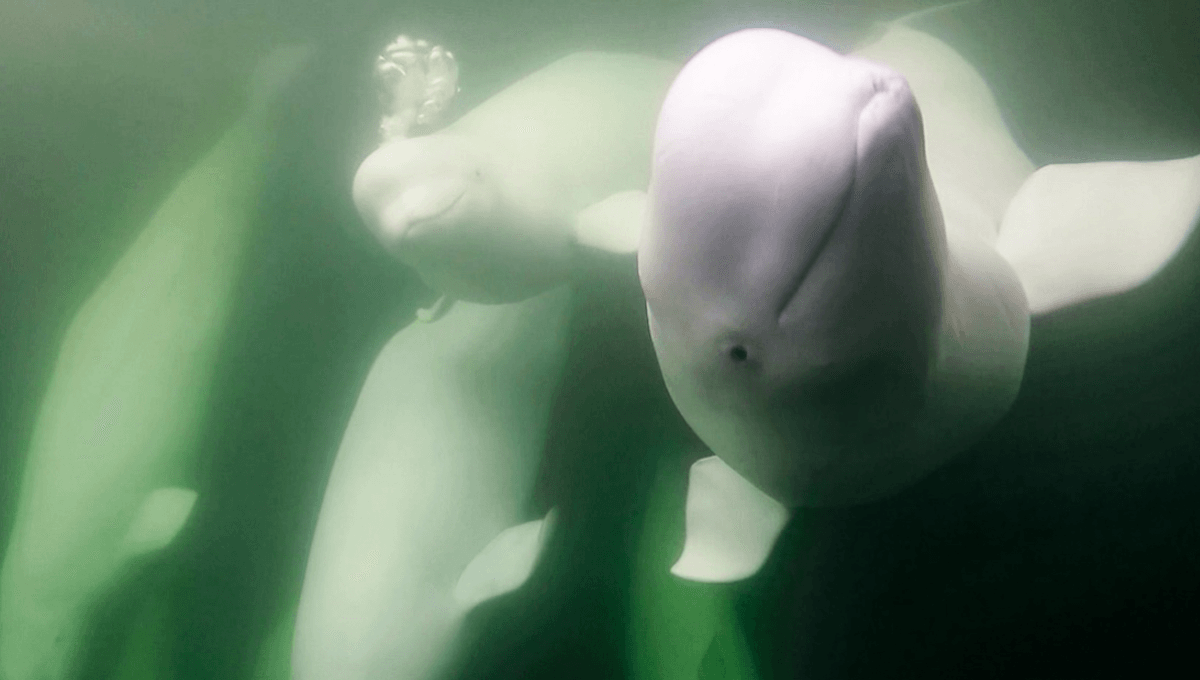
Did you know that the ocean has its own canaries? They’re a bit whiter and kind of enormous compared to the sort you see on land, but hoo boy, do they love to chatter.
Squeaks, clicks, buzzes, and babbling, little is off the cards when it comes to the remarkable complexity of beluga communication, but perhaps most extraordinary of all is the way in which they can manipulate their melons to get their point across. Don’t believe me? Get a load of this:
July 15 marks Arctic Sea Ice Day, an event that aims to raise awareness as to why these frozen landscapes are so vital not just for Arctic life, but our climate. The Arctic is now warming nearly four times as fast as the rest of the planet, and if sea ice loss continues the way it’s been going, many species like polar bears will be at risk of going extinct. It’s a vital cause for Arctic life, and one that coincides with the return of Polar Bears International and Explore.org’s Beluga Cams.
Beluga melons are not just lumps of fat, they are made up of several different tissue types, including muscles, connective tissues, and fats with differing densities and acoustic properties.
Jaclyn Aubin
If the quickfire assault of TikTok has got you feeling a little frazzled, might we invite you to immerse yourself in a relaxing alternative: kicking back with some belugas from the comfort of your home. The cams get going around the summer months because this is when Canadian waters are most likely to be ice free, and during this window about two-thirds of the world’s beluga population (approximately 150,000 whales) gather here. They arrive in their thousands to the Churchill River where they’ll feed, molt, and give birth to calves in the shallow waters.
It means you get an up-close look at some of the ocean’s most curious residents. A member of the cetaceans alongside dolphins and orcas, they have a few familiar features like big flukes, flippers, and a blowhole, but what really stands out is the giant lump on their noggins. What is it? Well, it’s something of a superpower.
“Beluga melons are not just lumps of fat, they are made up of several different tissue types, including muscles, connective tissues, and fats with differing densities and acoustic properties,” said beluga researcher Jaclyn Aubin, PhD candidate at the University of Windsor, to IFLScience. “These fats are important for both vocal communication and for echolocation and are used to focus and project the sounds that belugas produce. Several facial muscles and connective tissues are used to alter the shape of the melon, which allows belugas to modify their vocalisations, perhaps to deliver more focused and directional sounds.”
Particularly rambunctious males have been noted to expand their melons dramatically, suggesting that the shape of a beluga’s melon could provide clues to other belugas about their mood and behavioural state.
Jaclyn Aubin
Remarkable videos have shown the ways that a beluga can manipulate its melon while chatting away to its kin. While we’re on the way towards decoding whale language, we’re not sure exactly what they’re saying just yet, but it could be that the melon plays a role outside of sound.
“While alterations in the shape of the melon play a role in altering the vocalisations of belugas, they may also serve as a visual signal to other belugas,” said Aubin. “Particularly rambunctious males have been noted to expand their melons dramatically, suggesting that the shape of a beluga’s melon could provide clues to other belugas about their mood and behavioural state.”
It’s just another example of the complexities of beluga communication. We already know that they babble to their young, as well as using sound to wrangle the group, which can be particularly handy when young belugas start wandering.
“Beluga vocalisations are so complex that we still have not managed to create a full repertoire of all their call types, let alone understand the function of most calls,” said Aubin. “One call that we understand particularly well is the contact call, a call that belugas use to maintain group cohesion, and that mothers and calves use to stay close to each other.”
Want to get to know belugas a little better? Don’t miss Polar Bears International and Explore.org’s Beluga Cams this summer, available here.
Source Link: Beluga Whales Shake Their Blob-Like Melons To Say Hello And Even Woo A Mate, But How?